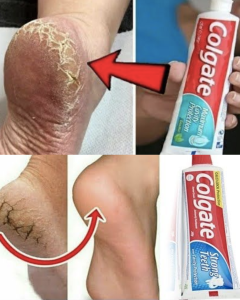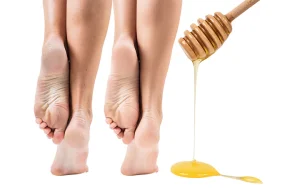Cracked heels refer to a condition where the skin on the heels becomes flaky and cracked, causing discomfort or even pain and making daily movement difficult. Although this condition doesn’t pose a significant health risk, it should be treated early to avoid affecting one’s quality of life.
1. What causes cracked heels?
In most cases, cracked heels are not too severe and may only cause slight discomfort, especially when walking barefoot. However, sometimes the cracks can deepen into the skin tissue, causing significant pain.

The common characteristic of cracked heels is dry, peeling, thickened, and cracked skin. The causes may include:
Medical causes:
- Diabetes: This condition leads to poor blood circulation and consistently high blood sugar levels, which cause dry skin. Moreover, diabetes can damage nerves, making it hard for patients to feel pain or notice cracked heels.
- Other health conditions: These include hypothyroidism, fungal infections, vitamin deficiencies, atopic dermatitis, psoriasis, dermatological conditions in adolescents, pregnancy, obesity, plantar keratosis (thickened skin), aging, skin fissures, cellulitis, and hyperkeratotic eczema.
Other causes:
- Standing for long periods of time;
- Taking hot showers or baths for too long;
- Walking barefoot frequently or wearing open-heeled shoes;
- Wearing tight shoes;
- Using strong antibacterial soaps or body washes that strip away the skin’s natural oils;
- Dry skin due to cold weather conditions
Cracked heels may be accompanied by symptoms such as itchiness, peeling skin, discharge, intense pain, inflammation, redness, and ulcerations. In particular, signs of infection like swelling, warmth, and redness at the heel area require prompt medical attention.
2. Why treat cracked heels with toothpaste?
Cracked heels are unsightly and uncomfortable, especially with weather changes. There are various home remedies, and one popular method is applying toothpaste to the cracked area to accelerate healing.
Toothpaste contains ingredients such as bleaching agents, baking soda, and fluoride, which help oxidize the cracks, remove dead skin cells, eliminate bacteria in the cracks, and speed up the healing process.

However, there is no scientific evidence supporting this method yet, although it is still used when necessary. The effectiveness of using toothpaste for cracked heels depends on each person’s skin type and the severity of the cracks. It is only a temporary fix and not a cure. For serious or infected cases, it’s best to seek medical advice.
3. How to treat cracked heels with toothpaste
Treating cracked heels with toothpaste is easy and can be done at home following these steps:
Step 1: Soak your feet in warm salt water for 10–15 minutes. This helps you relax, improves blood circulation, disinfects the cracked area, and softens the tough skin.
Step 2: After 15 minutes, dry your feet with a clean towel. Mix 1 tablespoon of white toothpaste with one vitamin E capsule and apply the mixture to the cracked heel.
Step 3: Leave it on overnight and rinse it off in the morning. You will notice a clear difference after just one use.
You should try this method 1–2 times a week to check for any negative reactions. If any irritation occurs, stop using it immediately to avoid infection or complications. If your skin responds well and results are promising, you may continue until the cracks heal.
As mentioned, toothpaste is only a temporary solution and does not address the root cause. It also depends on your habits and skin type, so avoid overusing it to prevent unwanted outcomes.
4. Other effective treatments for cracked heels
4.1. Exfoliate dead skin on your feet
The skin on the heels is often neglected during skincare routines, which makes it rougher and thicker. Soaking and exfoliating the feet is a useful method in this case. Keep the following tips in mind:
- Soak your feet in warm water for about 20 minutes;
- Use a pumice stone, foot file, or loofah to exfoliate;
- Let your feet air-dry and pat gently with a towel;
- Apply moisturizer to the cracked areas;
- Do not exfoliate dry skin as it may cause damage.
4.2. Use moisturizers
Moisturizers for cracked heels usually contain ingredients that exfoliate, hydrate, and soften the skin. Look for creams containing salicylic acid, urea, saccharide isomerate, and alpha-hydroxy acids.
When using these creams, apply 2–3 times a day to maintain moisture. Avoid walking barefoot and wear shoes to protect the heels. Always follow your doctor’s advice when choosing a cream; do not self-medicate as it might worsen the condition.
4.3. Use natural remedies
Some natural products are very effective for skincare, especially moisturizing the skin. You can try the following:
- Honey;
- Coconut oil;
- Olive oil;
- Oatmeal mixed with nourishing oil to exfoliate;
- Shea butter.

Among these, honey is known for its strong antibacterial properties, making it great for cleaning, healing wounds, and softening skin. Coconut oil is ideal for those with eczema, dry skin, or psoriasis.
5. Tips to prevent cracked heels
If you have experienced cracked heels before, choose soft, comfortable shoes and slippers to protect your feet, especially the heels. Avoid walking barefoot and instead wear sturdy shoes with wide heels to reduce pressure on your feet
Avoid wearing:
- Sandals or flip-flops, as they cause heel pain;
- Tight shoes, which can damage the feet and cause cracks;
- High heels or stilettos, which can deform your spine and foot arch, and cause heel pain and cracking.
Other prevention tips:
- Avoid sitting cross-legged or standing in one position for too long;
- Moisturize your feet regularly;
- Use heel cushions when wearing shoes to evenly distribute body weight and reduce pressure;
- Inspect your feet daily, especially if you have diabetes or skin conditions;
- Drink plenty of water to keep your skin hydrated and prevent dryness;
- Exfoliate dead skin, but never scrape off calluses or cracks if you have peripheral neuropathy or diabetes, as this could cause new wounds and lead to hard-to-treat infections.
In general, cracked heels are not a serious health concern for most people. To manage the condition effectively, it’s important to control any underlying health issues and consult a doctor if the cracks persist and significantly affect your daily life.
